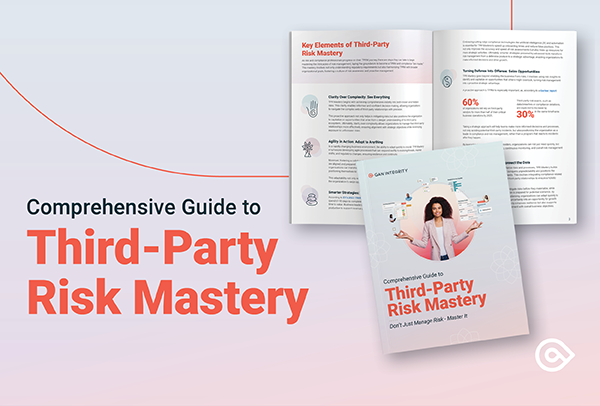In today’s hyper-global, always-on business environment, organisations are more reliant than ever on a vast network of third parties—vendors, suppliers, partners, and service providers. This interconnectedness brings tremendous opportunity, but it also introduces unprecedented complexity and risk.
As the third-party risk universe expands, so do the challenges of managing it. Manual processes are no longer sufficient to keep pace with the volume, velocity, and variety of risks organisations face. Enter artificial intelligence (AI): a transformative force reshaping third-party risk management (TPRM) by automating critical functions, enhancing efficiency, and introducing new dimensions of risk and reward.
Our report, created in partnership with Ethisphere, explores the growing challenges of TPRM and due diligence expectations, along with how technology like AI can help ethics and compliance teams build stronger TPRM programs by automating critical functions.
The Growing Third-Party Risk Landscape
The sheer scale of third-party relationships has exploded. Organisations now manage hundreds, sometimes thousands, of external partners. This growth is driven by globalisation, digital transformation, and the need for specialised expertise.
However, it also means that the risk landscape is broader and more complex than ever before. Heightened scrutiny around issues like human trafficking, trade compliance, environmental liability, and reputational risk has raised the bar for what constitutes robust TPRM.
Regulatory expectations are also evolving rapidly. Data privacy, cybersecurity, AI governance, and supply chain due diligence are now front and center. Companies must demonstrate not only that they understand their third-party risks but that they are actively managing them with rigor and transparency. The result is a demand for TPRM maturity that few organisations can achieve with manual processes alone.
AI as a Driver of TPRM Efficiency
AI is revolutionising TPRM by automating and enhancing key processes. Here’s how:
Automated Due Diligence: AI can rapidly assess a vendor’s security posture, financial health, and ESG (environmental, social, and governance) practices. By analysing public records, industry reports, and even social media, AI uncovers hidden risks that traditional due diligence might miss.
Continuous Monitoring: AI-powered tools provide ongoing surveillance of third-party risk profiles, alerting compliance teams to changes in real time. This enables organisations to respond quickly to emerging threats and maintain up-to-date risk assessments.
Risk Prioritisation: AI can sift through vast amounts of data to identify and prioritise risks, helping organisations focus resources where they matter most. This is especially valuable in large, complex supply chains where manual risk assessment is impractical.
Efficiency Gains: By automating repetitive tasks, AI frees up compliance professionals to focus on strategic initiatives. For example, Integrity Essential™ has been shown to reduce onboarding time by up to 50% and deliver risk screening that is ten times more precise than traditional methods.
AI: A New Risk to Manage
While AI offers significant benefits, it also introduces new risks that must be managed:
Algorithmic Bias: AI systems can inadvertently perpetuate or amplify biases present in their training data, leading to unfair or discriminatory outcomes. For example, an AI-powered recruitment tool might favor certain demographics, exposing organisations to legal and reputational risks.
Explainability and Transparency: Many AI models, especially those based on deep learning, operate as “black boxes.” This lack of transparency can make it difficult to understand or justify decisions, complicating regulatory compliance and stakeholder trust.
Data Privacy and Security: AI systems often require access to large volumes of sensitive data. Ensuring that this data is handled securely and in compliance with privacy regulations is a critical challenge.
Intellectual Property Risks: When third-party vendors develop or deploy AI models, there is a risk of IP leakage or misuse, especially if the models are not adequately protected.
Elements of TPRM Success
Ensuring best practices throughout TPRM programs help ensure proper AI governance, while also paving the way for efficiencies, cost savings, and innovation. Here are five pillars for building a successful, AI-enabled TPRM program:
Comprehensive Risk Identification: Use AI to map your entire third-party ecosystem, including “shadow” supply chains and Nth-party relationships that may otherwise go unnoticed.
Automated and Continuous Monitoring: Implement AI tools that provide real-time alerts and ongoing risk assessments, reducing reliance on periodic manual reviews.
Data-Driven Decision Making: Leverage AI analytics to prioritise risks and allocate resources efficiently, focusing on the most critical threats.
Integrated Governance: Develop clear policies and procedures for AI use in TPRM, addressing issues like bias, transparency, and data security
Stakeholder Engagement and Training: Foster a culture of risk awareness and equip teams with the skills needed to adapt to new technologies and evolving threats.
Conclusion
The intersection of TPRM and AI represents both a challenge and an opportunity. As the third-party risk universe continues to expand, organizations must move beyond manual processes and embrace technology to stay ahead. AI offers powerful tools for automating due diligence, monitoring risks, and making data-driven decisions. However, it also introduces new risks that require careful governance and oversight.
By building best-in-class TPRM programs grounded in the five pillars of success—and by leveraging solutions like GAN Integrity’s Integrity Due Diligence—organisations can balance risk and reward, protect their extended enterprise, and position themselves for sustainable growth in an increasingly complex world.
The future of TPRM is here, and when managed responsibly, AI can be a force for good. The organisations that succeed will be those that embrace innovation, manage risk proactively, and build resilient, future-ready risk management frameworks.
Want to read more on the risks and rewards of AI for TPRM? Explore the full eBook!

Colin Campbell is Gan Integrity's Strategic Product Marketing and Analyst Relations leader with over 15 years of experience in the SaaS software and tech industry. Colin has led analyst relations and product marketing growth strategies in North America, EMEA, UK and APAC, growing revenues in multiple industries. At GAN Integrity, Colin drives market expansion, demand generation and significantly enhancing customer retention, with a talent for aligning marketing strategies with business goals to deliver results.
